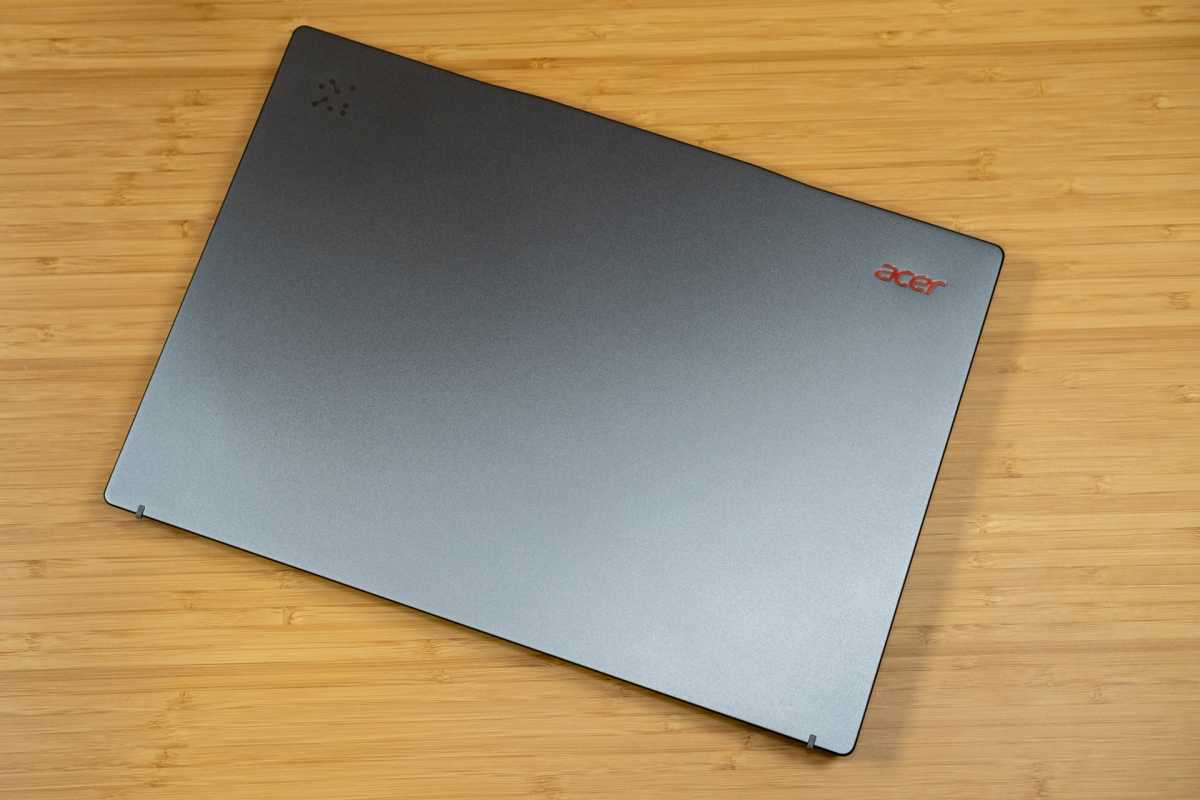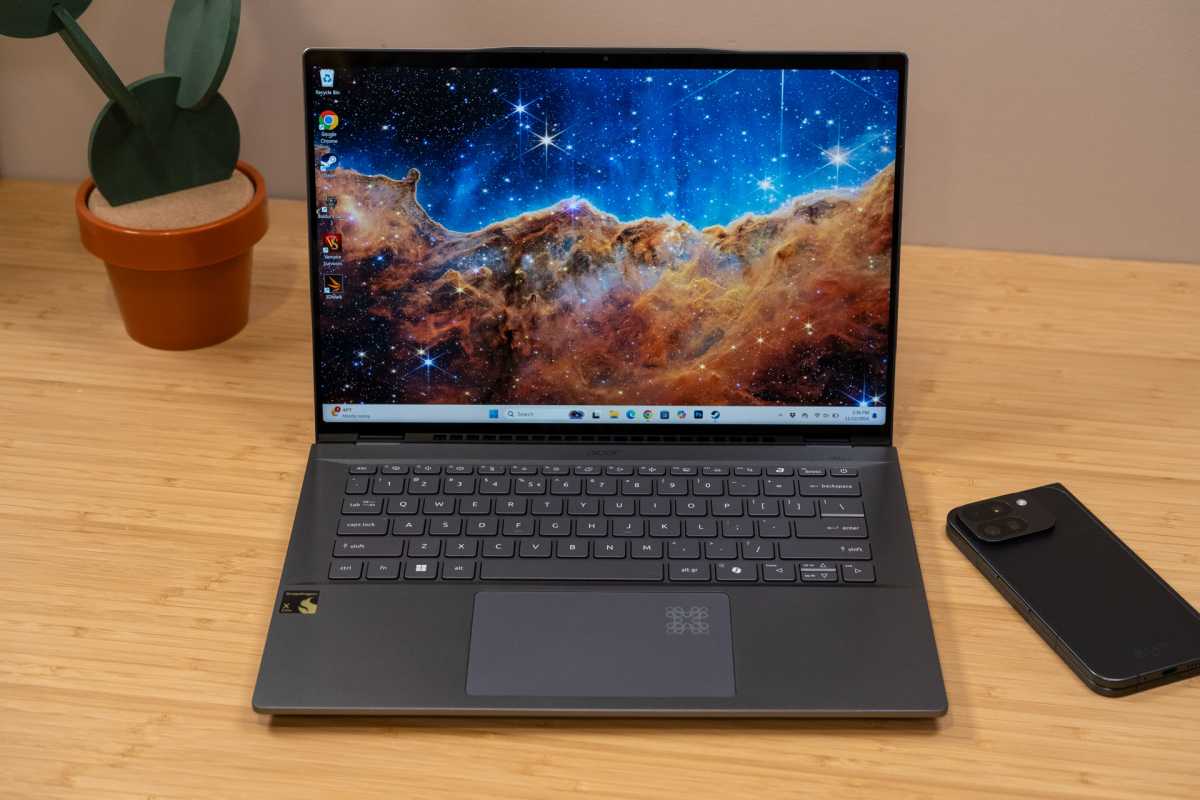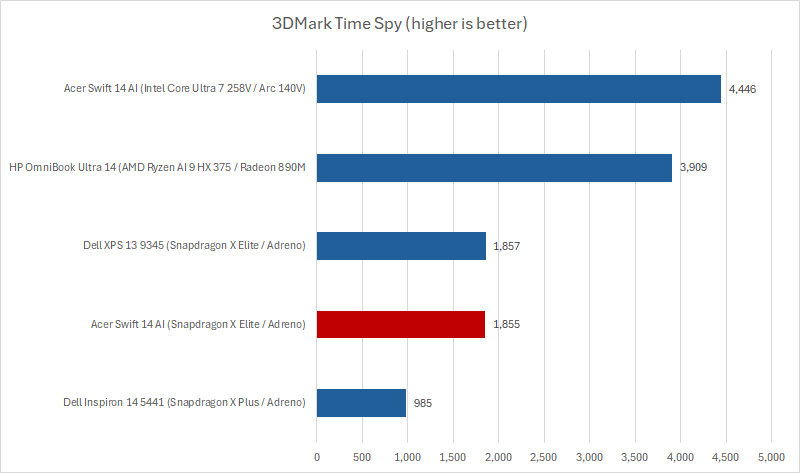
 Image: IDG / Ryan Whitwam
Image: IDG / Ryan Whitwam
At a glance
Expert’s Rating
Pros
Generous selection of portsLong battery lifeGood performance
Cons
Bad trackpadThe Intel version is fasterArm PCs still have compatibility drawbacksDim display
Our Verdict
The Acer Swift 14 AI offers solid all-around performance with the latest Snapdragon silicon and a generous selection of ports, but the trackpad is poor and Copilot+ features are still MIA.
Price When Reviewed
This value will show the geolocated pricing text for product undefined
Best Pricing Today
The Acer Swift 14 AI looks like an unimposing laptop that could easily be mistaken for any number of machines in Acer’s lineup. It has a secret inside, though. The Swift 14 AI is Acer’s first Arm-based notebook, running on Qualcomm’s Snapdragon X Elite processor. Laptops have changed a lot in the last few years as Arm-based chips have finally gotten powerful enough to run Windows. The Acer Swift 14 AI might not be the best representative of that change, though.
The Acer Swift 14 AI is slim and efficient, running for ages before it needs to recharge. It also has a pretty generous selection of ports for a thin-and-light laptop. However, the trackpad is below average, and there’s entirely too much bloatware. There are also issues that aren’t Acer’s fault—emulated apps don’t always work right and some hardware won’t play nice with Arm PCs. For the right price, the Acer Swift 14 AI can be a fine entrée to the world of Copilot+ PCs, but that price is not the MSRP.
Further reading: Best laptops 2024: Premium, budget, gaming, 2-in-1s, and more
Acer Swift 14 AI: Specs and features
You won’t have to make any difficult choices when purchasing the Acer Swift 14 AI. There are only two variants of the machine, one with a touchscreen and the other without. Both display options are the same 2560×1600 IPS. The touch version (which I have been testing) is $1,099.99, and the non-touch version is $1,049.99. The specifications are identical, so there’s no reason not to get the touch version for an extra $50.
Inside, the Acer Swift 14 AI sports a Qualcomm Snapdragon X Elite (X1E-78-100), a 12-core Arm processor that we’ve seen in laptops like Dell XPS 13 (9345). The capable Oryon CPU cores are backed up by an integrated Adreno GPU—similarly capable but not ideal for gaming on Windows. The machine comes with 16GB of RAM and 1TB of SSD storage, which is sufficient in 2024 but not class-leading.
CPU: Qualcomm Snapdragon X Elite (X1E-78-100)Memory: 16GB LPDDR5XGraphics: Qualcomm AdrenoDisplay: 14.5-inch 2560×1600 IPS, 120Hz, 300 nitsStorage: 1TB PCIe Gen 4 NVMe SSDWebcam: QHD IR Webcam (2560×1440)Connectivity: 2x USB-C (USB4, 40Gbps), 2x USB-A (USB 3.2), 3.5mm audio jackNetworking: Wi-Fi 7, Bluetooth 5.4Battery capacity: 75 Wh, 65W USB-C chargingDimensions: 12.7 x 9 x 0.66-0.72 inchesWeight: 3.2 poundsMSRP as tested: $1,099.99
Acer Swift 14 AI: Design and build quality

IDG / Ryan Whitwam
Acer’s first Arm laptop is a nice-looking piece of hardware, with a sleek aluminum chassis that is only 0.72 inches at its thickest point. The metal frame feels sturdy in all the right places, like around the keyboard and trackpad, but I did notice some visible flexing around the vents. The trackpad itself also has issues, which I’ll get to below.
The Acer Swift 14 AI is slim and efficient, running for ages before it needs to recharge.
The body should stand up to daily wear and tear alright, but it wouldn’t take much to leave a dent if you’re negligent when tossing it into your bag. It’s not overweight at 3.2 pounds, but I’d like to see a laptop this size at three pounds or less.
While the Acer Swift 14 AI sports a touchscreen, it’s not a convertible machine. It’s a standard laptop form factor with a reasonably sized 14.5-inch display. The bezels around the screen are slim, but not as compact as some similarly priced machines. The top bezel is a bit hefty, but it leaves room for the excellent webcam. The webcam above the display is better than most, featuring a 1440p resolution that can really show off the AI-enhanced Studio Effects, one of the few Copilot+ features you can access right now. The camera also has IR for Windows Hello biometric unlock.
The hinge is smooth and opens smoothly with one hand. However, the display is also prone to sagging if you move the laptop around while it’s open—it could stand to be a little stiffer, even if it’s harder to open.
You might notice the cluster of dots in the corner of the trackpad. This is Acer’s new AI indicator. The idea is that it’ll light up whenever your PC accesses AI features. Since most of Microsoft’s Copilot+ features are still in development, you’ll rarely see it illuminated. It might be an interesting quirk when there are AI features to use, but it could also be annoying. Luckily, you can disable the LED illumination in the settings.
Both of the machine’s USB-C ports are on the left edge. You can charge the laptop with either one, and you won’t be hurting for ports when you do. There’s a USB-A port next to the C ports, and there’s another USB-A on the opposite side. There’s also a 3.5mm jack on that side. That’s an embarrassment of ports for 2024. I also appreciate that Acer included a USB-C to HDMI adapter with the computer.
Acer Swift 14 AI: Display and speakers

IDG / Ryan Whitwam
The 14.5-inch display is a great size, splitting the difference between sometimes-too-compact 13-inchers and less portable 15 or 16-inch machines. The 2560×1600 resolution results in crisp visuals, and the 120Hz refresh rate ensures smooth animations. The colors and brightness consistency are also excellent for an LCD panel. Touch response is quick as well.
The peak brightness, however, isn’t very good. The screen maxes out at 300 nits, which is 100 nits lower than many other laptops in this price range. You won’t notice the deficit in dimmer indoor settings, but this screen can be hard to read outdoors or in a brightly lit office. The glossy finish doesn’t help, either.
Acer says this laptop has advanced audio tuning courtesy of DTS. Even the best tuning is limited by the hardware, though. The speakers are tucked under the left and right edges, which is common for laptops of all prices. They get loud enough to be heard over a noisy room, but there’s very little bass even after tweaking the sound profile in the included DTS app. The mids also get distorted past about 50 percent volume. It gets the job done, but this machine won’t set a new standard for laptop audio.
Acer Swift 14 AI: Keyboard and trackpad

IDG / Ryan Whitwam
The keyboard takes advantage of the available real estate to keep most of the keys close to their standard sizes. The up and down arrows share a single key unit, though, and the power button is crammed in next to backspace, which is one of the worst places you could put it. Acer is not alone in making that decision, though. HP also loves that easy to hit power button.
The keys feel better than most Acer laptops I’ve used. There’s a nice tactile bump and reasonable travel. The bottom isn’t too mushy, but you can see and feel the deck flexing if you’re a heavy typist.
The trackpad is a different story. It’s a good size, and the glass surface is smooth to the touch. The illuminated AI icon is an unnecessary addition, but it’s easy to ignore. The problem is structural—the trackpad has substantial droop toward the front. When pressing to click, I can see the trackpad pulling away from the case unevenly, which makes it feel cheap and flimsy. And even when it’s not being touched, the pad on my review unit sits higher on one side than the other.
Acer says the trackpad on this machine is within the normal manufacturing variance it expects. So unfortunately, the trackpad might be a deal breaker for some. If I bought a laptop with this trackpad, I’d probably consider returning it.
Acer Swift 14 AI: Performance
The stumbling block for Windows on Arm has long been applications—if they’re not built for the Arm64 architecture, Windows has to emulate them. Emulation was terrible on older versions of Windows, but Windows 11 does a reasonably good job. Simple applications work fine, but I’ve encountered issues with a handful of x86 programs, particularly installing them. You might also run into trouble with peripherals. Drivers have to be created for the Arm platform, so esoteric or vintage hardware probably won’t work.
In day-to-day usage, the Acer Swift 14 AI can handle all your basic computing tasks. When using Arm apps, the machine is indistinguishable from the average Intel or AMD-powered notebook. Emulated apps might be a little slower but not enough to notice most of the time. Games, however, will not run well on the Swift 14.
The Snapdragon chip does at least ensure your laptop will wake up quickly. Some Windows laptops can languish in the twilight between sleep and awake for a strangely long time, but this Arm-based PC is ready to go almost immediately.

IDG / Ryan Whitwam
Cinebench is a CPU-focused test that shows how a PC handles heavy but brief multi-core workloads. More CPU cores grant higher scores in Cinebench, and cooling doesn’t matter very much. The Swift 14 AI runs on the Snapdragon X Elite X1E-78-100, which is not the highest-specced version of the chip. It’s definitely the one we’ve seen the most often, though. Its 10 CPU cores push it well past the Snapdragon X Plus-powered Dell Inspiron 14. The Acer machine is only a few points behind the Dell XPS 13, which runs the slightly more powerful X1E-80-100 version of the chip.

IDG / Ryan Whitwam
Our preferred ARM gaming test is 3DMark Time Spy, a graphical benchmark that focuses on GPU performance. This result illustrates the problem with gaming on Snapdragon PCs. These chips can limp along in emulated games, but the integrated graphics in AMD and Intel chips are several times faster. You can get away with simple 2D games on the Snapdragon X Elite, but you’ll have to wait for native Arm games before we can truly take advantage of the Adreno GPU.
Acer Swift 14 AI: Battery life
Laptops today emphasize battery life like never before, with some models running a whole day without recharging. Arm computers are noted battery life champs, but the latest Intel and AMD chips are catching up. In some low-power configurations, x86 machines can even run a bit longer than Arm ones.

IDG / Ryan Whitwam
Our battery rundown test consists of running a 4K video at 250 nits on a loop until the laptop dies. The Acer Swift 14 AI manages one of the higher scores we’ve seen in this test at 1,050 minutes (about 17 and a half hours). You should not have any range anxiety while using this computer, and it charges reliably with any USB-PD charger and USB-C cable, to a maximum of 65W.
While the battery life is fine, it is interesting to see the Intel version of this machine actually lasts a bit longer. The gap is small, about an hour, but that’s still an impressive showing for Intel.
Acer Swift 14 AI: Conclusion
The Acer Swift 14 AI makes a good first impression with its solid aluminum frame and ample connectivity options, but it doesn’t quite make the sale. Acer’s trackpad feels cheap and even looks a bit off-kilter. The display, while very sharp and fast, is also a bit on the dim side, and the super-reflective glass will make it even harder to use in a bright environment.
It’s hard to judge the value of Copilot+ certification because almost none of those features are available. What limited AI there is at launch is heralded by the illuminated trackpad. This is an unnecessary gimmick, which you can turn off. In general, Acer goes a bit too far with preloaded software, too.
Possibly the best thing I can say about the Acer Swift 14 AI is that you can easily forget this is an Arm PC. Most x86 apps work just fine in emulation, and more Arm-optimized apps are finally becoming available. Games are off the table, but the laptop starts up quick and stays quick for the long haul.
Even with its drawbacks, the Acer Swift 14 AI could be worth picking up as your first foray into the Copilot+ world. However, you should wait for a sale. The MSRP of $1,099 is a bit steep for what you get. If you can find it for closer to $900 this holiday season, it could be a good value.
Author: Ryan Whitwam

Ryan Whitwam is a freelance tech writer, a fan of all things electronic, a long-time skeptic and a former research scientist. At PCWorld, he covers computer hardware and software.
Recent stories by Ryan Whitwam:
HP Victus 15 review: A budget gaming laptop with a 144Hz displayAcer Nitro V 16 review: Affordable mid-range gaming masteryLenovo ThinkBook 14 2-in-1 review: A laptop that means business


